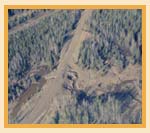Increased
Access
 The harvesting
of timber resources involves constructing temporary or permanent access routes.
As is often the case in Alberta, however, access roads may have been built
previously for exploration and development of petroleum and natural gas
resources. Improved access routes into the forest can benefit people other than
industry, particularly recreationists, such as off-highway vehicle enthusiasts,
hunters, anglers, and campers. Both controlled and uncontrolled access into
previously inaccessible areas can be harmful to some components of the forest ecosystem. Uncontrolled access to vehicular traffic, in particular, can lead to
symptoms of overuse. Soil compaction and erosion, damaged vegetation on
sensitive terrain and around watercourses are examples of these symptoms. The harvesting
of timber resources involves constructing temporary or permanent access routes.
As is often the case in Alberta, however, access roads may have been built
previously for exploration and development of petroleum and natural gas
resources. Improved access routes into the forest can benefit people other than
industry, particularly recreationists, such as off-highway vehicle enthusiasts,
hunters, anglers, and campers. Both controlled and uncontrolled access into
previously inaccessible areas can be harmful to some components of the forest ecosystem. Uncontrolled access to vehicular traffic, in particular, can lead to
symptoms of overuse. Soil compaction and erosion, damaged vegetation on
sensitive terrain and around watercourses are examples of these symptoms.
Sometimes
industry roads create access into areas with sensitive wildlife habitat, perhaps
a critical overwintering area for large game. Other wildlife species are
vulnerable because of their specific habitat requirements. Many of the larger
carnivores (e.g., bear, wolf and cougar) are less tolerant of the
inevitable human intrusions that accompany improved access and tend to avoid
these areas. When use by people increases, the usual result is reduced habitat
effectiveness for these types of species. When use by people is minimal, some
species (e.g., wolf) may take advantage of an access corridor as a travel route.
In addition, improved access and increased use of an area usually increases the
risk of human-caused forest fires. Finally, there are social impacts that affect
traditional land uses, and wilderness and heritage values.
To address these
and other access management issues, the Alberta government establishes
limitations on recreational use and access in environmentally sensitive forest
areas. As well, industries working in the forest recognize the impacts
associated with access and are taking steps to reduce these impacts. Strict
controls and planning processes are also in place to minimize impacts and
protect the environment.
Department of the Environment. State of the Environment Report, Terrestrial Ecosystems. Edmonton: n.p., 2001. With permission from Alberta Environment.
 |
|
 Heritage Community Foundation Presents
Heritage Community Foundation Presents





